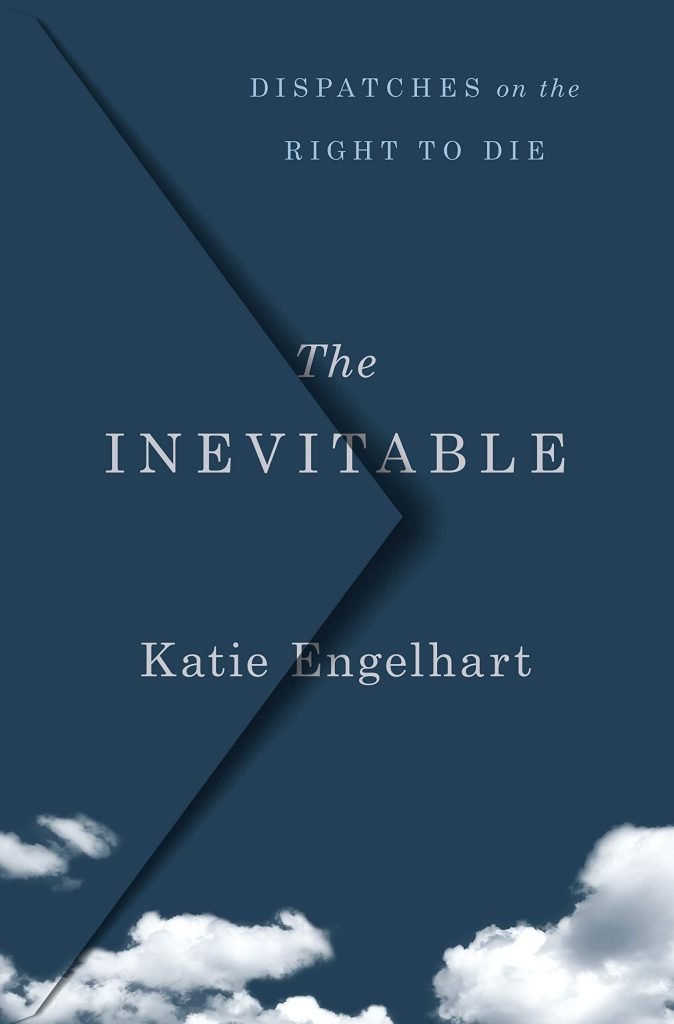The Inevitable: Dispatches on the Right to Die

Title: The Inevitable: Dispatches on the Right to Die
Author: Katie Engelhart
Year: 2021
Review by Faye Girsh
A flood of books and articles are being written — and legislation is being considered — on assisted dying. While thousands of fatalities occurred from Covid 19, laws permitting physicians to help people die were passed in Spain, Austria, New Mexico and being considered in both Australian and U.S. states and expanded in Canada.
This flurry of interest has brought new names and faces. Katie Engelhart comes to this investigation through journalism. Her refreshing new book, aptly titled The Inevitable, published by the prestigious St Martin’s Press in 2021, is important because of its candor and humanity. It takes the lid off the inadequacies of the Oregon model while acknowledging the impatience among many in the States — particularly well educated, white women — to take matters into their own hands. Fighting for more restrictive, doctor-directed laws to be passed with great reluctance by recalcitrant, religiously-influenced legislators is a goal of one segment of the right to die movement, while others are quietly but militantly finding ways to insure their own peaceful deaths using “underground” sources.
She exposes the problems of not permitting physician-applied lethal injection in the U.S., especially after the oral barbiturates that worked so well became unavailable. To comply with the requirements of self-administration in the U.S.,an ad hoc committee of doctors and pharmacists developed a formula of drugs that had to be compounded, tasted bitter, and often took many hours to be effective. Compared with other countries that permit MAID (Medical aid in dying) the US, or Oregon, model first passed in 1994, is the only one requiring a six month prognosis, which in itself is problematic in many ways — and not relevant to the more widely used criterion of “unbearable suffering.”
Engelhart tackles many taboo topics and discusses them thoroughly and without judgment from diverse viewpoints, including that of the sufferer. Dementia was the subject of 38 pages in Chapter 4, Memory. The pros and cons of providing assistance in early and advanced dementia were dealt with thoroughly, including the arguments about the “then” self and the “now” self when honoring an advance directive. Final Exit Network (FEN), usually not mentioned in other books, was the organization which provided support to the woman we meet struggling alone with early to middle dementia. Actual quotes from the Exit Guides who worked with her demonstrate the thin line they had to straddle between providing support for her self-deliverance while not assisting her suicide, an illegal act.
Though I would have liked more of a say about why I started this un-Oregon, un-medical model, which began in 1998 as the Caring Friends program of Hemlock USA. I was correctly quoted as passionately defending help for people with dementia, which she discusses in detail. We also hear from Compassion and Choices’ leaders who clearly and strenuously object to providing aid in dying in a devastating illness like dementia. FEN, when it’s referred to at all by other authors, is considered an “underground” organization but in Engelhart’s hands it becomes a welcome and sole port in a storm for a woman who is seeing her mind, independence, and personality slip away. She is also willing to talk about the important role of finances in making a decision to get “care” in an expensive institution. Whether or not to continue to live with diminishing finances and personhood should be a choice.
The people Engelhart spends time with in these chapters become real. We see them dealing with desperate situations and few options. Solutions are often found in non-establishment alternatives such as Exit International and its founder, Dr. Philip Nitschke, who began as the first doctor in the world to provide legal aid in dying and who evolved into a do-it-yourself advocate. His Peaceful Pill Handbook — in paper and electronically — are a resource for impatient people wanting to expand their “legal” resources. Angering advocates of legal change and the roles of doctors in providing assistance, Nitschke has provided instruction to independent people who want help figuring it out themselves.
In Chapter 5, Mind, Engelhart presents both sides of assisted dying for mentally ill people and, as is her great talent, allows us to experience the torment of a mentally ill person and the empathy of the unpopular psychiatrists who agree that prolonging his suffering is brutal and without justification.
She ends the 284 page book with a tribute to Derek Humphry whose best-seller, Final Exit, “set things in motion for my entire project.” There is some sense of irony in that since her book reflects the tension between the do-it-yourself (DIY) of Final Exit and the struggle to legalize help in dying that has occupied many of our lives. The success, since 1991, of a self-deliverance textbook, in three editions and 12 languages, made it clear that people want a way out of endless suffering, when they say they’ve had enough. The Inevitable, though not such a text, offers an excellent, humane, and readable synthesis of these positions from the objective but compassionate view of a journalist. Engelhart is a newcomer to our movement but, thankfully, she understands, can explain, and is on the cutting edge of our current dilemmas. She has made a significant contribution!
